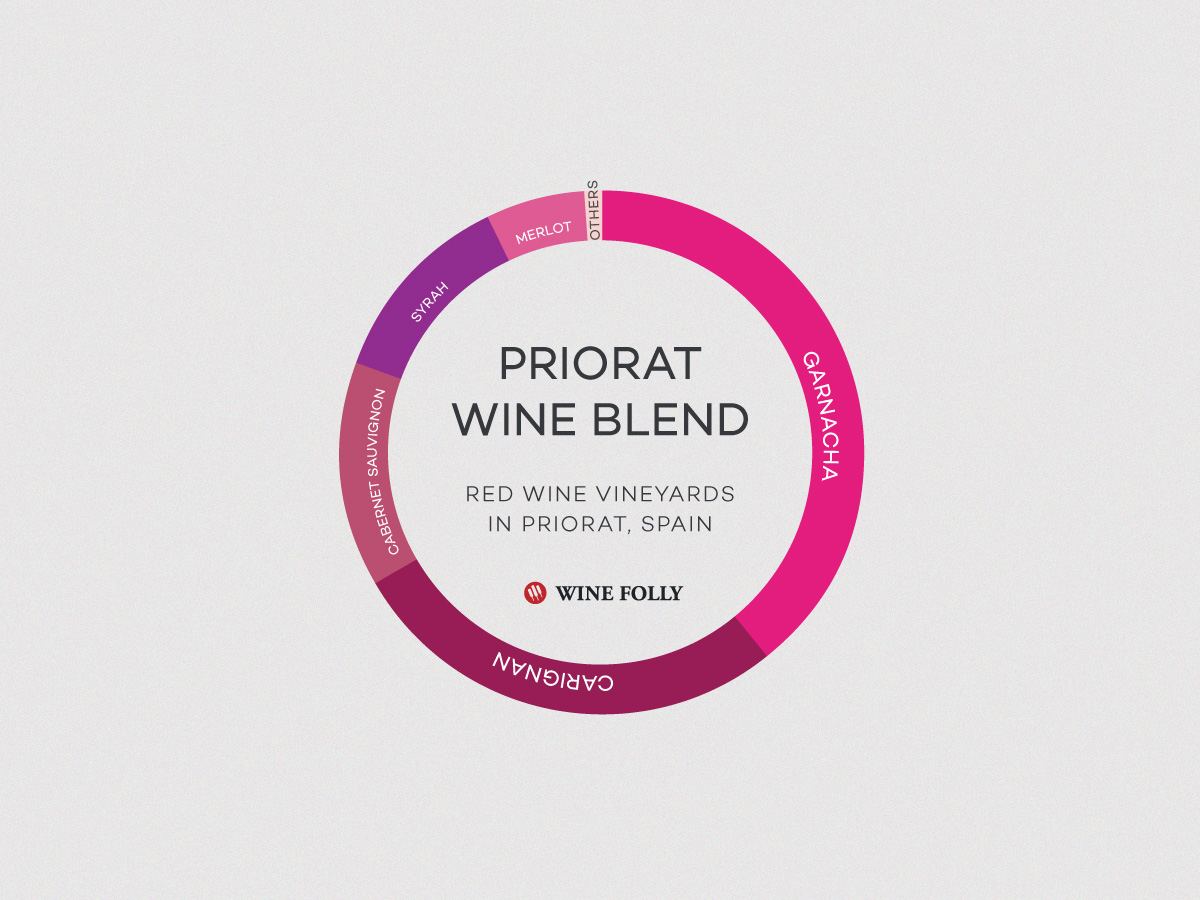Looking for the best Priorat wine? This tiny, rugged region just south of Barcelona has earned a reputation for bold, powerful reds that reflect its dramatic landscape.
With steep, sun-soaked vineyards that are largely unsuitable for anything but grapes and olives, Priorat produces wines that are as intense and distinctive as the terrain itself.
Despite its small size, the region has a rich winemaking history and a modern resurgence that has earned it a place among Spain’s finest wine regions.

The Wines of Priorat
A Lil’ History
The region has a record for winemaking since the creation of the Cartoixa d’Escaladei Priory in 1163 (Escaladei means “ladder to god” in Latin). Carthusian monks who had learned vineyard techniques in Provence, France, tended the land in Priorat for nearly 700 years until 1835, when lands were claimed by the state and redistributed. By then, Priorat had grown to nearly 12,350 acres (5,000 hectares) of vineyards and earned a reputation for winemaking.
In the late 1800s, however, phylloxera destroyed the vines, collapsing the industry and depopulating the region.
By the mid-1970s, Priorat had nearly ceased to exist as a wine-producing region. Decades of Franco-era agricultural policies prioritized subsistence crops over quality wine production, leaving many vineyards abandoned.
While the government made Priorat an official D.O. (Spanish official wine appellation) in 1954, it wasn’t until 1989 that things started to change. A handful of passionate winemakers saw the region’s potential and set out to reclaim Priorat.
René Barbier gathered a group of passionate winemakers and viticulturists to produce site-specific wines in Priorat — a gamble that paid off. They adopted the term Clos, meaning ‘protected’ or ‘walled’ vineyard, in their winery names.
The original five labels — Clos Mogador, Clos Dofí (now Finca Dofí), Clos de L’Obac, Clos Martinet, and Clos Erasmus — all received intense international attention and high ratings for their outstanding wines in the mid-1990s.
There are now 5,426 acres of vineyards with over 100 wineries (and 500 growers). Producers today still adopt the term Clos in their names to champion the idea of site specificity. Many also complement traditional oak with concrete eggs, amphorae, and other innovative methods, combining old-world techniques with modern experimentation.
Priorat was granted the higher-level DOQ (Denominació d’Origen Qualificada) status by the national authorities in 2009.
The Wines of Priorat

In 2025, Garnacha and Cariñena are the focus grapes, with smaller amounts of Cabernet Sauvignon, Syrah, and Merlot. Exact percentages vary by vintage and producer.
The dominant vineyard plantings in Priorat are Garnacha (aka Grenache) and Cariñena (Carignan). These two grape varieties are the backbone of nearly all Priorat red wines, although there is no legal requirement for a minimum or maximum percentage of any variety. Young Cariñena vineyards rarely produce high-quality wine. But many bush vines in Priorat exceed 90 years. Their low yields concentrate flavors, creating intense red-fruit driven wines.
The other red grapes that contribute to the creation of Priorat blends are Tempranillo, Piquepoul, Cabernet Sauvignon, Cabernet Franc, Pinot Noir, Merlot, and Syrah. Allowable white grapes for white wine making include Grenache Blanc, Macabeu, Pedro Ximénez, Chenin Blanc, Muscat of Alexandria, Muscat Blanc à Petits Grains, Xarel·lo, and Piquepoul.
Taste of Priorat Wines

Sun-dried red and black plum, black cherry, and cassis (red and black currant) dominate the aroma profile of high-quality Priorat red wine. Beyond the fruit, you’ll notice a distinct, “black stone” or “hard rock” minerality that some experts relate to the iconic Llicorella slate soils of the region. Descriptions of the aroma can include wet summer pavement (“petrichor”) with a little bit of wet clay; what you might imagine smelling while riding a bike during a summer rain.
The typical structure of Priorat offers soft, moderate acidity that balances with big, brawny tannins, and relatively high alcohol (usually in the 14% and up ABV range). Additional flavors might include some saline notes (such as Maldon or smoked salt) and spicy notes (cinnamon, cardamom, or molasses), often with a somewhat herbal, minty, or licorice-anisette finish. Finer Priorat wines offer harmoniously intense flavors that evolve through multiple stages, from fruit to savory to spiced.
Expect to spend: Entry-level Priorat reds typically start around US$50–70, while top estates for old-vine Garnacha and Cariñena can easily exceed US$100. Farming here must be done by hand, and the wines often undergo aging in new oak, which explains the high starting price.
Priorat Region in Detail

The 12 sub-zones of Priorat get their names from different local villages. You may see Priorat wines with “Vins de Vila” on the label from one of these specific zones. Keep in mind that most wineries surround the largest villages of Gratallops, Porrera, Poboleda, and Torroja, but great quality can be found throughout the region. A detailed look into the regulatory document on Priorat shows that the 12 villages can be grouped into four primary taste styles.

General Taste styles of Priorat’s 12 sub-zones
- Wines with big structure and high tannins: El Lloar, La Morera de Montsant, Bellmunt, Poboleda
- Wines with big structure, tannin, and a long aftertaste: Gratallops, Escaladei
- Harmonious wines with finer tannins: Molar, Porrera, Masos de Falset, Torroja
- Finessed, elegant wines: Vilella Baixa, Vilella Alta
Last Word on Priorat Wine
Priorat’s story is inspiring; to think about how the work of a small group of winemakers (who shared resources) was able to change the fate of an entire region, so much so that the wines of Priorat are among the finest (and most expensive) wines of Spain. Priorat’s success, born from the marriage of people and place, presents as a great story, but an even better wine.
